Now more than ever, keeping a journal, especially a faith journal, may be a beautiful thing to do. Perhaps you already know the countless benefits to journal-keeping and you’re practicing it. Or maybe you don’t know and are curious? For now, I’m not going to dig into all that, but I will be returning to explore and share more. (If you want, check out this post for a simple way to start.) Today, I want to talk about how to choose your journal tools. We’ll start with the place and then get into the fun stuff that will help take you from chore-journaling to joy-journaling.
Disclosure: This post contains affiliate links. If you make a purchase from a link, I may earn a small commission—at no extra cost to you. As an Amazon Associate I earn from qualifying purchases.
First Journal Tool: the Place
Any place will work, but it’s best to give this some thought. Obviously, there are no rules here, and what works for me or your best friends may never work for you. But consider these basics:
- Calm–a place where you won’t be interrupted, even if it’s for 5 minutes. Maybe that’s your kitchen table before everyone wakes up or after everyone has gone to bed. Or a desk, a cozy chair, a front porch swing.
- Comfortable–a place where you won’t get a crick in your neck or a cramp in your foot. A cozy chair might work well for you. I prefer a desk where I can keep fairly decent posture. If writing in my journal makes my shoulders ache, I won’t keep it up for long.
- Consistent–a regular spot where the minute you show up and open your journal, your brain will say, “Oh yes, this is where I spill out onto the page.”
How to Choose a Practical Journal
You can use absolutely any kind of paper or notebook you have on hand. Don’t go out to buy something new just to begin. Unless you want to and unless getting a new notebook gives you a thrill. (If the previous sentence makes no sense to you at all, then just grab a spiral notebook that’s leftover from your kid’s Western Civ class. Tear out the notes so at least you have a fresh start.)
But please, don’t go buy a super expensive notebook that’s too pretty. Not yet. This is the number one mistake new journal writers make. They get all situated in their place with a pretty notebook and matching pen, and then they freeze. Can’t write a word. They might mess up this pretty book.
So stop with the pretty just for pretty sake unless you are strong enough to step over that first blank page. You can do it, but it may be putting too much pressure on yourself when you’re just starting. Remember, we are trying to focus on how to choose journal tools that will work for you.
- Loose leaf paper. It’s great because you can grab a couple sheets and take it anywhere. I’d suggest you put it into a 3-ring binder or one of those inexpensive paper folders when you fill a page. Otherwise you will be likely to lose the paper. Unless you want to lose the paper or throw it in the bonfire later, in which case this is a lovely option.
- Spiral notebook. Super practical, inexpensive and easy to write oodles and oodles of words or mind-maps. They lay perfectly flat. Choose a color that makes you smile. Also, figure out ahead of time if you prefer wide-ruled or college-ruled. If you aren’t sure, look at your handwriting or printing. Do you write big swooping letters? Or are you a tiny writer? Choose accordingly because it’s really frustrating if you pick the wrong one. (Seriously, I’ve abandoned more than a few journals because they were wide-ruled. That does not work well for me.)
- Composition notebooks/softcover. These are wonderful little gems, the black and white marbled ones that actually say “Composition Book” on the front. They come in lots of different colors. Wide and college ruled paper. Inexpensive (less than $3 each), lightweight, easy to lay flat. The only downside of these is that they might bring back memories of diagramming sentences or spelling lists. You’ll know by just looking at them. If your heart starts to beat faster–not in a pitter-patter fun way–then choose something else.
- Hardcover spiral journals. These are nice because they have the hard cover that will take a lot of wear and tear, especially if you like tossing your journal into your purse or backpack to carry with you. The spiral is really nice because it will lay flat. I use one of these for my book journal. Some have pretty pictures, graphics, or even words. They are fairly inexpensive at your local office supply or craft stores.
Are you ready to choose a pretty journal?
If you want to dive into the deep end right away, here’s an intro, especially if you notice little details when it comes to choosing your journal tools — or when it comes to choosing anything at all. I’ll share what I’m currently favoring at the end, but for now here’s what to consider:
- Paper quality/weight. You might have heard about GMS. It stands for Grams per Meter Squared. (Oh boy, am I back in geometry?) Without getting even more technical, it’s good to know that the thicker the paper, the better the quality. Does it really matter? For most people, no. But if you ever have the chance to write on really nice heavy paper, you’ll notice the difference. Especially if you are using a really nice pen. (Pens! Yes, I‘ll talk about those another time.) I have learned how much I love writing on heavier paper. It’s kind of like breathing in fresh air, skating on a smooth surface, skipping a stone across a glassy lake. Graceful. Easy. Lovely.
- Paper color. Lots of nice notebooks have cream or ivory colored paper. Some have white. Obviously, it’s personal preference. I prefer white but those can be harder to find.
- Style. Lots of choices here. Plain pages. No lines at all. Great if you like to doodle, draw, sketch and write. Lined, like traditional notebook paper. Dot-grid pages (my preference) because I get some guidelines but not overwhelmingly so. Grid pages, like graph paper.
- Binding. Overwhelming number of choices here. Notebooks can be bound by glue, stitching, staples, and spiral. I’m using a stitched journal for my current faith journal. It’s lovely but has its downsides.
- Size. You can find everything from the biggest A4 to the smallest A7. These letters only matter if you can’t figure out the actual measurements. Just choose what’s comfortable for you.
- Cover. Manmade, soft-cover, hard-cover, paper, leather. Lots of options.
- Cost. If you go with the higher-quality paper and covers, you can spend anywhere from $18 to well over $100. (Seriously.) However, you can find lots of lovely choices under $20. Here are two great notebooks. You’ll have fun just looking at the cover colors! Check out the pretty pink Leuchtterm1917 and this Rhodia.
My Current Journals
I am currently using three different journals. (Yeah, I’m a little crazy, but please don’t feel you need to start here. Or even start at all. I’m sharing just to give you some ideas as you learn how to choose your journal tools. Or a distraction from whatever work you are avoiding. Because honestly, don’t we all sometimes read about things that we may never actually do? Wink. Wink.)
- For my reading log, I have a spiral bound with a pretty impressionistic picture on the front. (I write about reading logs here.)
- I’m also using a blue Leuchtturm1917 as my capture-journal for all kinds of lists and notes. I’ve been using this journal for several years since I started to bullet journal. I love their paper, the cover color choices, and the fact that the name of the journal means “lighthouse” in German. Here’s how to pronounce it, if you want to know. Their tagline is “thinking with the hand.”
- For my spiritual journaling right now, I’m using a stitch-bound book journal from Barnes and Noble with a lovely leather-like cover. I bought it a long time ago to collect quotes. It’s pretty, but it’s not the most practical because it’s really thick. Once I fill it, I’ll switch to something with fewer pages.
So there you go. Some ideas to help you choose your journal tools. Next week I’m going to get all geeky about pens and pencils. In the weeks ahead, I’ll share more about spiritual journaling, book journaling, and all kinds of ways even non-writers–especially non-writers–can practice these things.
I’ll close with a reminder that your words matter.
Let the words of my mouth and the meditation of my heart
be acceptable in your sight,
O Lord, my rock and my redeemer.
Psalm 19:14 ESV
Photo by Cathryn Lavery on Unsplash
Pin this post for later!




